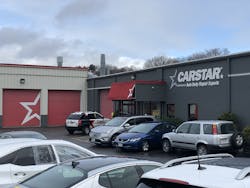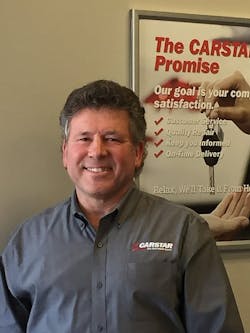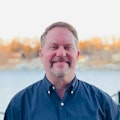Waldron’s Autobody CARSTAR plans for expansion despite the pandemic
As he approaches his 40th year as an MSO owner, Bob Waldron said he’s still passionate about the collision repair business. In fact, he looks forward to adding at least a couple more shops before he retires, aided by a veteran staff and proven systems and processes.
The coronavirus pandemic has created a number of challenges for Waldron, who owns four CARSTAR shops in the Boston area. But he’s pressing forward with expansion plans for the near term.
| At a Glance: Waldron's Autobody CARSTAR |
| Bob Waldron Owner |
| 1981 Year founded |
| 4 No. of locations |
| Boston Area served |
| 50 No. of employees |
| BASF (R-M Diamont) Paint supplier |
| 300-350 per month Average car count |
| $9 million Annual gross revenue |
| CCC One Estimating and management software |
“Our business is way off right now — and has been since the middle of March — and it shows,” he said. “We laid off quite a few people. Believe it or not, we were supposed to have a closing in the month of May,” he said. “But this corona thing has thrown everybody off. I think they won’t even talk to you. We had a verbal with everything; we’ve been working on a location for a little over a year. We had everything all lined out, and then the coronavirus came in.”
Waldron began his auto body repair education as a high school freshman and bought his first shop, in Marlborough, Mass., when he was only 20 years old. That was his only location for almost 20 years. In 2000, he began the first of three acquisitions, the location that would become Waldron’s A-1 Auto Body CARSTAR, in Lancaster. He followed that with Hanna Color Auto Body, in Clinton, in 2010, and Thomas Waldron Auto Body, in Worcester, in 2013.
For Waldron, it’s worked well to focus on acquisitions, not greenfield startups or facility conversions and rehabilitation that can take more time and money to meet zoning and code requirements. When looking for an acquisition, he looks for an operating collision repair business of about 10,000-12,000 square feet — a size that makes it easier for Waldron to remotely oversee.
“I like to dress things up, and I don’t know sometimes when to stop. Budgets are like laws; they’re meant to be bent or broken, you know?” he laughed. “I have a tendency of going overboard, so that’s another reason I try to stay away from the renovations.”
What makes a prime acquisition candidate for Waldron?
Waldron operates in a business climate that’s a little unique for collision repair shops, he pointed out. There are no major consolidators in the state, in large part because the state effectively has outlawed direct repair programs. Thus, his competitors and other acquisition targets tend to be smaller facilities.
Near Boston’s city center, high land values have resulted in some body shops closing and selling their property.
“It’s getting worse now. There are body shops closing, and they’re getting bought out by developers for a pharmacy, a Dunkin’ Donuts, or condos. They’re squeezing out the body shops because they’re paying a premium for the land.”
So how does Waldron gauge potential in an acquisition candidate?
“I think like anything else, you have to have a feel for the area,” he said. “In fact, I got a phone call a week and a half ago and I have to look at another one.”
Even before social distancing was limiting how much people were able to venture out, Waldron could gather information remotely by checking out the shop’s website and looking at its photos on Google Earth or Street View.
“If it’s neat and clean, you’ve got my attention. And within an hour, I can figure out what their competition is in that area and what the population is.”
Although a candidate shop having updated capital equipment is a plus, the one piece of equipment that is most important is the spray booth. That’s because of the time required to have plans approved, inspections passed, remove the old booth, and get the installation scheduled, which can take up to a couple months. Waldron likes to have a quick transition to his operations.
Typically, Waldron makes a deal with the seller for the vehicles that are works-in-progress so that Waldron bills the seller for the work done on them to complete them. Over a weekend, everything gets pulled out of the shop, it’s pressure-washed, and repainted with the CARSTAR gray and red colors.
“So we have something going from day one. The cash register is ringing, so to speak. It’s hard to start from ground zero and then go up; you walk before you run. You use the existing name for a while, and then you add yours; you blend them, and then you blend them out. It depends on the previous owner’s reputation, how fast that process is.”
Small facilities, big results
Before the widespread pandemic lockdowns in the area, Waldron’s four shops had been delivering between 300 and 350 vehicles per month, for a total of about $9 million per year in sales. In some months, one of the shops can do $170,000 a month in sales out of just 3,000 square feet. The smaller shops stay productive by focusing more on smaller hits or cosmetic repairs, while heavy hits are sent to the larger shop in relatively rural Lancaster, which is only about 20 minutes from the farthest Waldron’s location.
“We also have a towing company, and we do the police towing 24/7 for three towns. So usually when they have to be towed, they’re pretty big hits. That’s the store where we do what we call our ‘train wrecks.’”
CARSTAR membership helps Waldron’s meet challenges, prepare for growth
At his first opportunity, Waldron joined the CARSTAR network as a franchisee in 1990, shortly after the company was founded the year before by Lirel Holt. Waldron already had a close working relationship with Holt while Holt ran the 3M Auto Repair Management Software (ARMS) workshop.
Waldron has been a member for the past 30 years, and as a member of CARSTAR’s EDGE Performance Group (“20 group”), he is able to network with other MSOs and gain encouragement and insight as to what has been successful in their businesses. A corporate representative may be knowledgeable, he pointed out. But the advice has additional impact when it’s from fellow MSOs from noncompetitive markets in how they approach their operations of multiple locations. It’s made all the difference in allowing him to expand.
“You take chances and you struggle; you have your ups and downs, you know? But all in all, in my opinion, going with more than one location is the way to go if you want to survive today. I think you couldn’t do this 20 years ago, though. We didn’t have the technology, we didn’t have the information, and we didn’t have proven track records on how to run multiples. We even have an IT professional to help with that. Today is a different day and age.”
Running multiple shops and maintaining CSI and NPS scores requires employees to be on board with corporate goals, he continued.
“You have to have a good staff who believes in your dreams and your goals. And you have to make sure everybody is buying in and doing the right thing through SOPs and a lot of checks and balances.”
Formal technical training program, I-CAR Gold status
As a high school freshman, Waldron went to Assabet Valley Regional Technical High School in Marlborough thinking he may study either carpentry or auto mechanics. But those two subject options were not available, and he ended up in the body shop class. He quickly found he enjoyed it, though, and he chose to continue on that educational path through high school. “The rest is history,” he said.
Understanding that recent trade school graduates often fall through the cracks without encouragement from fellow workers at their first shop, Waldron implemented a mentor/mentee program written by his part-time human resources manager.
“They come in as DFR [Disassemble for Repair] techs, so they disassemble the vehicle properly: nice, neat, and organized.”
Once the mentor checks off that those tasks have been mastered, the mentee advances to removing small dents and continues to advance. Once the mentee completes that program, the company buys the newly minted technician a starter tool set. If they stay with the company for six months, the tool set is theirs to keep.
“It’s a nice little incentive for them. We’re not spending thousands of dollars on them, but we’re spending a few hundred dollars. I don’t try to convince anybody that this is how they’re going to spend the rest of their life, here at one of my facilities, but if you prove you can come in every day on time with a good attitude, a clean uniform, and with good work ethics, I’ll work with you.”
Education does not end with formal training, Waldron recognizes, which is why he pays for all of his staff to be I-CAR trained. And all of his facilities are I-CAR Gold-recognized. [Waldron pointed out there are no DRP agreements to require it.]
That education is more important as vehicle complexity increases, which is why Waldron’s shops adhere to OEM repair information for each repair, sourced from ALLDATA, CCC, and I-CAR’s Repairability Technical Support Portal. Waldron said he stresses to technicians that the correct repair is not always how the vehicle was constructed — or what may seem the most straightforward method.
“My rules, my ideas, and my wants don’t mean anything anymore. What does the manufacturer say? Sometimes, techs and I will look at what the manufacturer recommends, and it doesn’t make sense. But I tell them, ‘Guys, this is what they’ve done. They’ve put a lot of R&D into this and quite frankly, if something happens after we fix it and it doesn’t hold, some attorney’s going to make mincemeat out of us for not following those guidelines. So do the guidelines. It’s not about us anymore.”
OEM-certification programs have not shown ROI
Waldron said he had participated in multiple OEM-certification programs, but this is the second year he has not renewed them. Although he sees their utility, he hasn’t seen the ROI.
“I started to look at it a little differently. We’ve got the lowest labor rate in the country and no DRPs, and now we’ve spent a lot of money on OE certifications, I-CAR Gold, and all of the equipment and training we need certified for Honda, Ford, aluminum, Hyundai and Kia and so forth. And then they want me to give them $3,000 annually per store to be on their list so I can fix their cars properly.
“I do the math for all the stores and all the certifications, and we’re talking some serious monies. If they want their cars to be done repaired perfectly after the accident, then why do they want me to pay for it? How much more do they want from us? We’re getting paid $35 or $40 an hour for the labor rate out here, and now we’ve got to start paying to be on your list? It just doesn’t make sense.”
Adjusting operations to the pandemic
At the time this article was written, Waldron was planning to use the pandemic-induced slowdown as an opportunity to catch up on needed maintenance.
“We just talked about the “New Plan” for the next few weeks of doing some work to the building, both inside and out, cleaning up some of our vehicles (we have about a dozen or so cars, pickups and tow trucks,) and we’re doing online training for I-CAR, CARSTAR U and CCC.”
Waldron is quick to credit his staff for his enduring success.
“I wouldn’t be where I am today if it wasn’t for our people. I have employees who have been with me for coming up on 30 years. I couldn’t be here without a handful of people along the way. As far as I’m concerned, I still have a long way to go, but I just thank the people all around me. CARSTAR has been very good for me. It’s a very good, positive program that’s been very helpful over the past 30 years. It offers a lot of great things; you just have to get out of your shop and get involved in something somewhere down the line, pay attention, and find a system and use it.”
About the Author
Jay Sicht
Editor-in-Chief, FenderBender and ABRN
Jay Sicht is editor-in-chief of FenderBender and ABRN. He has worked in the automotive aftermarket for more than 29 years, including in a number of sales and technical support roles in paint/parts distribution and service/repair. He has a bachelor's degree in journalism from the University of Central Missouri with a minor in aviation, and as a writer and editor, he has covered all segments of the automotive aftermarket for more than 20 of those years, including formerly serving as editor-in-chief of Motor Age and Aftermarket Business World. Connect with him on LinkedIn.
Don't miss Jay's next article or podcast. Sign up for FenderBender Today's Collision Repair News and ABRN eNews here.


